Devon Trevarrow Flaherty's Blog, page 34
April 17, 2021
Book Review: The House of Sixty Fathers
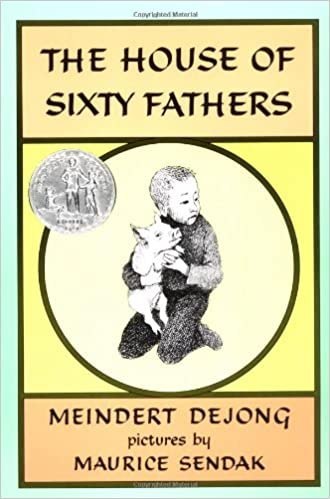 Image from Amazon.com
Image from Amazon.comOne of my favorite books in elementary school was The Wheel on the School by Meindert DeJong. For my review of that book, see HERE. When my co-op, language arts class of middle schoolers arrived at The House of Sixty Fathers, I was excited to read something else by DeJong. And though it is from the ‘50s, Sixty Fathers was a contender for the Newbery Award as well as won Hans Christian Andersen and ALA awards.
Where were we at in history? (Our readings coincide with what they are learning in history class. This year they are studying modern history.) World War II. We just read a book about the Holocaust (obliquely; Number the Stars), so what would this one be? There was a Chinese boy and some domesticated animals sketched on the cover (by none other than Maurice Sendak, who also has illustrations throughout the novel). Well, we’ve also studied the Second Sino-Japanese War, a war-within-wars. Bingo. This is the story of a little boy, Tien Pao, whose family has just fled the Japanese army as it destroyed their Chinese village. They’re still in shock and barely surviving the aftermath when a storm blows Tien Pao, his pig, and his ducklings back down the river and into Japanese occupation. He’s all alone, but he’s smart and resilient, and he just wants to get back to his family.
DeJong wrote this book after he was an airman in World War II stationed in China. His platoon adopted a Chinese refugee orphan. When the war ended, DeJong tried to adopt the boy, but he was not able to and lost contact with time. (There is an airman in the book, as well as other similarities that I don’t want to detail and give away.) This book is something like the classic, survival novels. While the protagonist is younger than is typical, you’re on the edge of your seat with uncertainty, watching little Tien Pao navigate hostile enemies, hold on to what is dear to him, and search for food while he traverses difficult terrain. In other words, there is leaf-eating and bleeding feet here. While I found the writing to be acceptable and the story pretty good, I was internally perched on the edge of my seat for the last quarter of the book and I was in no way certain how this would turn out. It is a bit intense for kids, which is maybe why it’s sold more to middle schoolers, but even for them… we see gunners and doomed civilians, we see starving children and doomed pets. We see war and we realize war doesn’t just affect grown-ups.
For that reason, I would recommend this book. While China may feel a long way away (as well as the 1940s), children are going to connect with Tien Pao. They might be a little raked over the coals, but this is fiction, an adventure story, and one that keeps the reader wondering throughout. They’ll learn some Chinese culture words and concepts, and they’ll put themselves in Tien Pao’s shoes. Written in non-flowery language with a fairly fast pace, The House of Sixty Fathers may be a stretch for current PC concepts of cultural appropriation (for the extreme), but it will also be a favorite of some students. The real question is whether or not you should focus their attention, as a parent or teacher, on the storybook positivity of it or the underlying current of tragedy.
April 12, 2021
Book Review: The Dog Owner’s Manual
 Image from Amazon.com
Image from Amazon.comI have shared before that I have two main, strong, stress response behaviors: shopping and reading. This is how I cope. Turns out, when I have real, deep grief with shock, I don’t do either. I also don’t eat, which is something that has never failed me in my entire life. It’s been a week since I cracked a book, but I am going to get back on the horse by reviewing the few books I had finished a couple weeks ago including The Dog Owner’s Manual by Dr. David Brunner and Sam Stall. It is painful: the reason I can’t read, eat, shop, or sleep is that my Barney-pup died suddenly in a tragic accident last week. Still, I know there are lots of great dogs out there and people who love them, so here we go.
The Dog Owner’s Manual came highly recommended on the internet, which is why I settled on it. Surprisingly, there were not that many books that fit what I was looking for: a type of manual for getting and having a dog. Not a book about feeding them and making food (though I was in the market to buy one of those eventually). Not a book about breeds. Or specifically about training. I wanted a quick graze over the whole gamut of pet ownership, with some emergency advice, etc. For what I wanted, this is exactly the book.
It’s small enough to stick in your dog bag (or what we called the Barney Bag). It’s pleasant to peruse, and things are organized so that you can just look things up. Full of cute, stylistic, duochrome illustrations, I can’t think of anything it doesn’t touch on, though it obviously doesn’t go very in depth in specifics. The one complaint: the style. What begins as a clever and snicker-funny ploy ends up making you want to leave this little gem on the coffee table while you purchase something similar that doesn’t employ gimmick. (Not sure this exists. Sorry.) What am I talking about? Well, take a look at the title: The Dog Owner’s Manual. Subtitle: Operating Instructions, Troubleshooting Tips, and Advice on Lifetime Maintenance. This book is part of a limited series that uses the language of electronics ownership to inform about owning things more organic. While you might assume this cutesy wordplay ends at chapter headings or even just the title, let me assure you that it never stops. Down to the last chapter, “Obsolenscence and Deactivation,” the Appendixes, “Troubleshooting” and “Technical Support,” and, indeed, the last phrase, “the warranty for which can never expire.” Not only do I imagine that some people would have a difficult time interpreting everything in this book, especially rapidly, even more with-it readers are going to tire of the analogy. Like on page five.
All in all, I would recommend this book, though I wish it existed in a more straight-forward format, one that didn’t pretend indefinitely that my dog is a computer that I just purchased. Har har. Otherwise, a great book to have on hand for all those dog questions, especially if you don’t want to constantly be googling.
Of note: the book gave the correct advice for our situation. It does not list toxic foods, however. We had a list on the fridge, which you can print out from the internet or buy as a fancy magnet.
April 5, 2021
Book Review: It’s Not Supposed to Be This Way
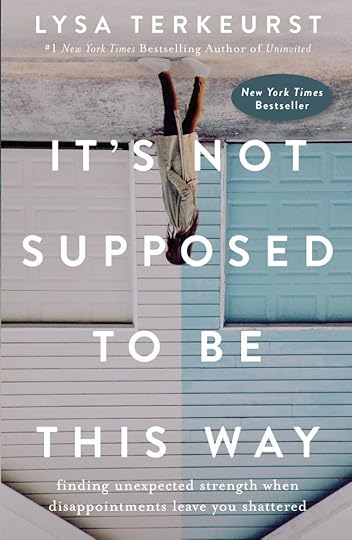 Image from Amazon.com
Image from Amazon.comIt’s Not Supposed to Be This Way by Lysa TerKeurst was on my TBR because I pulled it from some pandemic book club suggestions I had compiled at the beginning of the year. I started a pandemic book club in January, and It’s Not Supposed to Be This Way was our second Christian reading, our last Christian selection for the year. I have heard TerKeurst before on the radio and read her brief encouragements in my email inbox, as a voice of Proverbs 31 Ministries. I enjoy her short and sweet, thoughtful and simple words. Not only did I think that I would like her as a long-form-writer, but I also thought that the book—about how to respond when your world is topsy-turvy (say, in a pandemic)—would be just right for me and for my book club members at this time.
It’s Not Supposed to Be This Way is a type of devotional book, a modern Christian self-help book of faith-builders and encouragement. It centers around TerKeurt’s struggles over the couple years when her husband of many years cheated on her and she was diagnosed with cancer. It was a tough time. How did she respond? What did she learn from it? Where was God when it really, really hurt? That is the book we have here.
There was an article this morning in the New York Times. It said that we have entered a new phase of the pandemic, at more-than-a-year. Personally, it seems like it’s been a long slide in this direction, but anyhow, the article said whereas we were hyper-productive in some of the earlier stages, we are now in behavioral anhedonia, “a reduced ability to take pleasure in activities.” And we’re not motivated to do anything, anymore, even the normal things like get out of bed or wash the dishes, let alone make sourdough bread or repaint the house. We’re lethargic, lacking interest, and we’re coping by meditating, drinking alcohol, eating too much, walking, practicing our religion, writing letters, giving gifts, and adopting pets. (For me, eating and adopting pets rings most true.) My point being that I and billions of other people currently feel that “it’s not supposed to be this way!”
While the subject matter may be relevant (though it’s dealing more with major catastrophe and not long, drawn-out seasons of stress, fear/denial, information wars, and decision fatigue), it didn’t totally hit home for the season. For me. I have been through seasons like TerKeurst is writing about—blinding, life-altering, personal catastrophe. Perhaps this book would have been a friend, then. It has some things to say and there is no doubt that TerKeurst’s story, book, and voice have helped a lot of mostly women through tough times and crises of faith. But I was distracted by the lack of theological rigor (Is that true?, I would wonder), a strain of cheesiness, and also the broken cadence. This cadence is a style, but it’s not one that I tolerate well, even in writing for middle grades and children. You’ve seen it: paragraphs are broken into several, sentences in halves, etc. Why is each sentence its own paragraph? Someone must like it that way. Not me. I did like the cover and the layout of the printed page. Maybe a litle gimmicky, but modern and effective.
I think TerKeurst’s writing is at its best when she is telling a story. Most of the time, though, she’s simply giving encouragement and she often lost my attention. I wasn’t underlining on every page, starring and double-starring, and wondering how I could choose quotes for the review. In fact, I would often go a page and then wonder what the heck I had just read. It felt vaguely like I had heard it before and then zoned out. Plus, I wasn’t tethered anywhere and the writing wasn’t flowing in an organic way. I found truths here and there, but the experience wasn’t a cohesively amazing one.
There are notes, scriptures, and a prayer after each chapter, which one would appreciate, especially if they wanted to go deeper with this book. In the end, some of the platitudes I needed to hear and TerKeurst is plenty friendly and vulnerable, but the book itself was scattered. As is often the case, the majority of reviews are by fans who have been touched by this book and who totally disagree with me. If you are more of a reader of the Christian classics and a student of theology, maybe this isn’t the tough times read for you. I’m sure there’s something else out there more along the lines of life-currently-sucks for the likes of us. As for the legions of women who attend her conferences and read her books, this is another one to check off the list and glean from.
_______________
QUOTES:
“Together we will find a way to tie our hope not to specific outcomes we thought were the only way back to normal, but rather to the very heart of God” (pxiv).
“But disappointment isn’t proof God is withholding good things from us. Sometimes its His way of leading us home” (p4).
“If we weren’t ever disappointed, we’d settle for the shallow pleasures of this world rather than addressing the spiritual desperation of our souls” (p17).
“If [Satan] can distract us with the negative narrative of ‘not good enough,’ we will miss the metanarrative, the grand overarching story of redemption in which God intends for us all to play a crucial role” (p79).
March 14, 2021
Book Review: Till We Have Faces
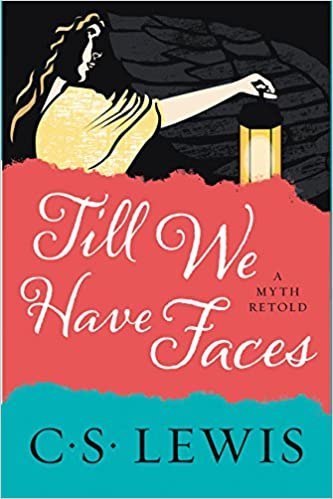 Image from Amazon.com
Image from Amazon.comEvery once in a while, I pull an old favorite off the shelf and give it a read so that I can review it, fresh, for you. Till We Have Faces is one of my favorite books. Never heard of it? I’m sure you’ve heard of C. S. Lewis, the Christian apologist who also wrote the Chronicles of Narnia series. Well, Till We Have Faces is the last book he wrote, and it is both exactly something he would write and also something very distinct from the rest of his writing (which is comprised of the two categories of children’s fantasy and Christian theology). Till We Have Faces is a fantasy, officially, (though definitely not children’s) but it makes more sense to tell you that it is a rewriting of the Greek myth of Cupid and Psyche but told in a strong first-person, almost stream-of-conscious, perspective of Orual, the supposed older sister of Psyche.
Orual is the eldest daughter of the King of Glome, which is not a pleasant thing to be. She is restricted by her gender, despised for her looks, and frequently abused by the king. When the new queen dies in childbirth, Orual is tasked with the raising of the third princess, a task she shares with the only friend of her childhood, the slave-tutor, the Fox. It is clear from the beginning that Istra is special, surpassing everyone around her in all giftings including beauty. The gods can’t leave it at that. They must have Istra, for better or worse, leading Orual in a battle of the wills and a search for their many faces. Even after a few readings, you’re still discovering the truth behind the screen of Orual’s unadmitted anger and jealousy.
In general, I like to read third-person stories, not first-person tell-alls. (I also don’t usually favor dream sequences, but there is something about using dreams for authenticity here, that works better than usual.) First person writing often makes me feel suffocated, as though I’m reading through cotton. By nature, it also tends to tell more than it shows, and I am definitely a fan of showing much more than telling. But this novel is a complaint against the gods—which Orual tells us in the opening sentences—and I can’t imagine a greater need for the use of the first-person voice. The effect here is complete. We’re a hundred per cent stuck in Orual’s head. It’s not always clear. It’s not always true. It’s not always pleasant. It’s a journey, more spiritual than anything, though it’s also an emotional, relational, and chronological journey. Do we like these characters? We certainly have sympathy, and at times empathy, for them.
I have enjoyed reading ancient mythology since I was a child. This book is cool because it uses modern story-telling style and devices to blow open ancient (barbarian) Greece and its interactions with their gods, as well as retell a classic myth, and all while entertaining with good writing, immersive exploration of life and its meaning, and really strong characters and setting. It’s not very long, it’s not difficult to read. I would highly recommend it for students of Greek mythology, fans of C. S. Lewis, speculative fiction people, and just about any other teen-adult reader. If I were a high school teacher, I would also be tempted to include this in my assigned reading, as long as you could get away with the religious discussions that it would encourage. Knowing Lewis’s other works, it is interesting to think about where he was coming from, why he chose this story, and what he means to tell us by it.
_______________
QUOTES:
“’And as for death,’ she said, ‘why, Bardia there (I love Bardia) will look on it six times a day and whistle a tune as he goes to find it. We have made little use of the Fox’s teaching if we’re to be scared by death’” (p72-73).
“To leave your home—to lose you, Maia, and the Fox—to lose one’s maidenhead—to bear a child—they are all deaths” (p73).
“I said not long before that work and weakness are comforters. But sweat is the kindest creature of the three…” (p91).
“I perceived now that there is a love deeper than theirs who seek only the happiness of their beloved. Would a father see his daughter happy as a whore? Would a woman see her lover happy as a coward? My hand went back to the sword. ‘She shall not,’ I thought. Come what might, she should not. However things might go, whatever the price, by her death or mine or a thousand deaths…” (p138).
“Oh, Orual—to take my love for you, because you know it goes down to my very roots and cannot be diminished by any other newer love, and then to make of it a tool, a weapon, and thing of policy and mastery, an instrument of torture—I begin to think I never knew you. Whatever comes after, something that was between us dies here” (p165).
“I was with book, as a woman is with child” (p247).
“I thought I had before me a huge, hopeless pile of seeds, wheat, barley, poppy, rye, millet, what not? And I must sort them out and make separate piles, each all of one kind. Why I must do it, I did not know, but infinite punishment would fall upon me if I rested a moment from my labour or if, when all was done, a single seed were in the wrong pile” (p256).
“We bring our ugliness, in both kids, with us into the world, with it our destiny” (p282).
“Till the word can be dug out of us, why should they hear the babble that we think we mean? How can they meet us face to face till we have faces?” (p294).
Media in Review: February 2021

Angus, Thongs, and Perfect Snogging (2008)
Just as I have been neglectful of posting my media review of the entire month of February, so was I remiss in January in not including Angus, Thongs, and Perfect Snogging. This is another of the movies in my never-ending slog through the movies that I personally own. It’s not a slog, yeah, true, because I like these movies, but it will take approximately forever. Three months in and I am still in the Bs, and some of the time I was pretty regular about watching them. Not complaining. Saying. Anyhow, I own this movie because I like it, though it has been a really long time since I saw it. I imagine I watched it with my BFF who moved away, as she is really into teen culture and this movie would be something she would have thrown at me some weekend evening. In many ways, It’s based on a couple books (including Angus, Thongs, and Perfect Snogging) by Louise Rennison. They might be worth a read, coming in at Goodreads at like a 3.8. The movie is pretty standard, except that it reaches out to an older audience with the teens. There are some “inaapropriate” scenes (although pretty innocent compared to much of what we see on the screen today), as well-adjusted misfit Georgia navigates the mine fields of parents, first love, major life changes, friends, sexual awakening, etc. It’s funny and interesting and well-acted and it’s great that family and parents don’t take a back-seat to everything else that’s going on in Georgia’s life, so if you like British teen rom-coms, then this will be your jam.
 Image from twitter.com
Image from twitter.comThe Trump Insurrection (CNN special, 2021)
Yeah, I was paying attention as January 6th, 2021 went down, but I read and listen to my news, not watch it, so when this special aired, I was curious to see. It’s pretty short, and there was definitely footage and new information that I hadn’t seen or heard yet, so I’m glad I watched it. It wasn’t life-changing and I don’t think I need to watch it again (just as it wasn’t innovative reporting), though I wouldn’t mind sending someone there to get the facts. (Yes, I know CNN is left-leaning, though their non-opinion pieces are closer to the center. Go ahead and argue. It won’t be very fulfilling when I don’t argue back.) At any rate, if you’ll watch CNN (via HBO), this is a quick watch that catches you up to speed on this recent day in history.
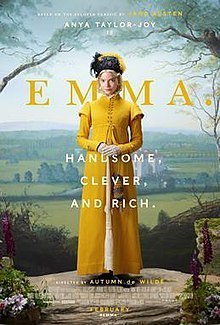 Image from Wikipedia.org
Image from Wikipedia.orgEmma. (2020)
This movie hit all the right notes for me. Okay—there was one thing, and that was the heroine occasionally addressing the camera with her eyes and maybe it was a bit strange when the nose bleed happened. The looking at a camera is a trend, now, but it was hardly necessary in this movie and added absolutely nothing. Besides that, love it, love it, love it. I already love the story, as I list Emma by Jane Austen as one of my favorite books. The movie is a tad quirky (which we all know I enjoy), romantic, visually saturated, with artistic cinematography, good acting, good chemistry, and great costumes. In other words, this movie is eye candy and, since it’s classic Jane Austen, also a great story. If you want it to be totally traditional, then you might not love this as much as those of us who don’t mind a fresh, modern twist (although not as much of a twist as changing the time period or genders or something). I guess that’s all I have to say about that.
 Image from Amazon.com
Image from Amazon.comBest Baker in America (2017-2019)
This is a really standard Food Network show, complete with hosts, judges, and even some contestants who are already familiar to us if we watch the channel much. I like Jason Alexander, so him as a participatory judge was something I enjoyed (that, and Marcella’s clothes and hair). Though, like I said, otherwise just really standard, which is maybe why it didn’t last. Or maybe it was the pandemic. Because it’s usual, I enjoyed it enough. These are not amateur bakers, as in some of the competitions, but professional ones, so seeing what they would come up with and the techniques to get there was a treat for the foodie-amateur chef. If you like competition food shows, this one is worth a watch.
 Image from ABC57.com
Image from ABC57.comSuperbowl LV (2021)
Usually, we would be at some Superbowl party, often with family, though some years in the past we just stayed at home while others went to parties. So, come to think of it, the Superbowl didn’t change tremendously for us, this year, except that I forgot to shop for it and then had to wing it on the spread of dips and chips and shrimp cocktail and things. (Therefore, there were no actual wings this year.) Then I struggled to find a way to watch it (some secondary CBS app on our Roku) and then plopped down with an art project. Because I don’t really watch the Superbowl. I discovered, after growing up in blue collar Midwest and being on the marching band for four years, that my ADHD and complete lack of interest in spectator sports leaves me with a knowledge of the game that my attention span rarely lets me use. And still, I watch the Superbowl with my two non-sporty kids. For the commercials, of course, and the half time show. This year, I thought we were on point with everything. The commercials, in deference to the pandemic and other social issues, lacked that racy, wow-factor dimension and instead concentrated on humanity (though I realize much of it was affectation), narrative shorts, a ridiculous number of high-level cameos, and nostalgia. (I kept joking that the actors were just happy to get some work, finally.) As for the half-time show, I thought The Weeknd did a great job, even able to incorporate mask-wearing and social distancing into his typical look and message and still entertain and occasionally wow. (NFL has it posted on YouTube, if you missed it.) I was surprised at his choice, but it worked out well. On the other hand, I heard that the game was somewhat flat. Wonder what next year will look like, all around.
 Image from IMDB.com
Image from IMDB.comWANDAVISION (2020)
There’s been a lot of talk lately about Wandavision, yet another Marvel Comics spin-off. This one is a TV show (streaming on Disney+) and this might be just the first season. I am tired of the Marvel and DC Comics glut and its relentless insider feel, but everyone in the family was curious about this one, so we watched the episodes on family take-out night until the season wrapped (in March, actually). At first, it felt a lot like The Good Place to me, though I was told I was just plain wrong. It famously begins with several strange, retro episodes that keep your finger on the power button but, at the same time, keep you from pushing it. It feels unrelated to where we must be headed with this show—just a 1950s sitcom and then a 1960s sitcom and then… you get it… all starry the Scarlet Witch and Vision and with a very light foreboding and a few scenes of life on the outside. Despite this totally funky take on the typical comic book hero show, it does eventually become much more like you’re watching just another Marvel movie, and in the meantime, if you aren’t already immersed in the universe, you can get a little lost and need a husband to point out what you’re missing in the plot. It’s worth watching as a family show (especially with teens), though, and I wonder if it will have another season.
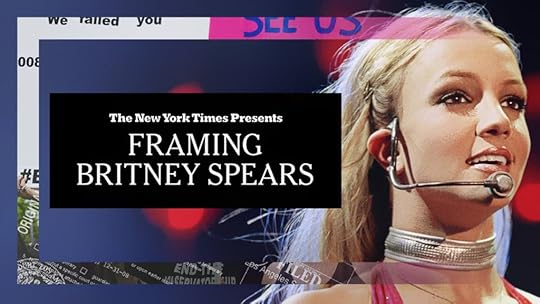 Image from youtube.com
Image from youtube.comNew York Times Presents: Framing Britney Spears (2021)
I don’t know what it was, but when I saw an ad for this episode/special of New York Times Presents, I fast-tracked it to my screen. I have always been interested in the real life behind fame, but I was never a Britney Spears fan. It was fairly well done, and if this subject matter—Britney Spears as a child star whose life was destroyed by a combination between the paparazzi, unstable mental health, and a voyeuristic father (or was it?) and whose lack of charge of her own career and fortune well into her adulthood has prompted a cultural phenomenon of supporters—then you should go ahead and stream it. It does end with a giant question mark (partly because we are just now in the middle of another country battle for Britney’s “freedom”), portraying Spears as the best-kept secret of pop America—or just America. But that title: I can’t help but think it’s meant to be a double entendre. Sure, we understand we are getting a portrait of the artist and her tumultuous relationship with the media, therefore “framing” her like a picture, but it seems obvious that the Times is also saying she was “framed,” and therefore the innocent (somewhat) in the ongoing fiasco. She was framed by the paparazzi, the news media, even the American people. But that’s stronger in the title than in the actual story. I guess. It’s very nuanced for reportage and leaves us with a lot of questions and a developing story.
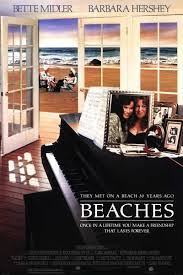
Beaches (1988)
Moving along in the B’s of my movie collection. This is one of my oldest favorite movies, meaning I have enjoyed watching it since I was a kid. Besides The Sound of Music, my childhood movies tended to have a bleak streak, which I think comes from experiencing death first-hand as a child. Anyhow, this is a movie classic, was wildly popular at the time, launched a very popular song (“Wind Beneath My Wings”), and starred the popular Bette Midler, even though it is a bittersweet tragedy. The story of two girls from opposite sides of the country and the tracks, they meet as children under the boardwalk (and another popular song was born). The story follows their individual lives (mostly from Bette’s perspective) and their friendship as they grow up and begin to grow older. There are ups and down, comedy and tragedy and of course, love, as Bette croons her way through a singing career, giving us what is not a musical but feels like it. Eventually, there’s a daughter and an illness and the bittersweet tragedy comes in to play. It’s a solid movie with a compelling though mellow story, great acting and singing, and a great nostalgic feel.
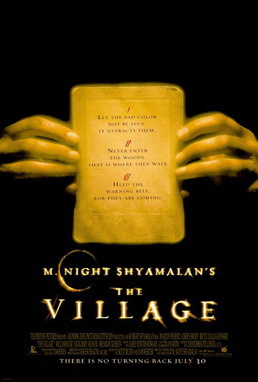 Image from Wikipedia.org
Image from Wikipedia.orgThe Village (2004)
M. Night Shyamalan made some really exciting and popular movies. Unfortunately, as each one released over the years, they were more and more unpopular, and most would argue worse and worse. All the notoriety started with The Sixth Sense. This newest film centered its focus on a small village in colonial America, where the villages are never allowed to leave for fear of the beasts that lurk in the woods. Amidst relationship snaggles and small-town intrigue, someone ends up sick and needing medicine from “The City,” but no one’s allowed to go to The City… The Village is a period thriller, well sorta, but I don’t want to give anything away, because that’s Shyamalan’s m.o.: supernatural suspense with a twist ending. I was super-pumped to see The Village back in the day, and I wasn’t as hard on it as others. Since my kids like Stranger Things and The Quiet Place, when we saw this on streaming one evening, we watched it as a family. While I still think it’s well-done, with great acting, suspenseful and unique story, and visual beauty and eeriness, I didn’t remember the one reason I really didn’t end up like this one: it’s so sad. The twist comes in a one-two punch, this time, and while the two-punch really works on the page, the character it involves didn’t play creepy enough for us and we’re way too sympathetic. It breaks our heart. And both my kids said, “Mom, that was too sad.” Yeah, for me too. For my much more cinema-jaded husband, it was a fine one-time watch for the Shyamalan fan and would be a good Halloween movie for us non-slasher horror people.
(I’m struggling to keep up with reading this month, so I watched less movies.)
 Image from Amazon.com
Image from Amazon.comA Star is Born (2018)
I remember a couple years ago people talking and talking about this movie. It was a must-see movie from back in the days when people were still going to movie theaters, pre-pandemic. The feature song played on repeat on the pop radio stations and then it got stuck in your head. (It is a great song, it just ends too early.) And Lady Gaga! Who knew she could act as well as sing? Then everyone was talking about a supposed (not true) relationship between the main leads, their chemistry “on and off the screen,” and then the awards ceremonies came and… Well, this Valentines, for the first time ever, my husband and I didn’t go out. We got take-out and sat down to pick a movie and when we saw this we were like, “Oh yeah, we meant to see that years ago. ‘Bout time.” And we tucked into our Thai food. Too much prelude, I know, but I don’t have too much to say about this movie. For someone who watched the frenzy and praise without having seen it myself, it was underwhelming. The story—about an “ugly” girl who becomes suddenly famous and her already-famous, alcoholic boyfriend—is super-standard. (This is also the second remake of this movie, so I guess that might be why. It is a recycled story, and it’s one we’ve heard before. The real fireworks, I guess, is in the music performances and the acting, which is pretty good. I don’t want to be all down on this movie: it’s well-made. But don’t going looking for something to blow your socks off, and maybe it will.
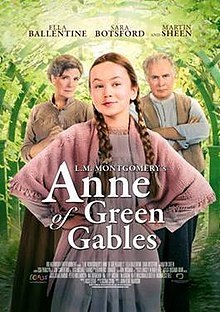 Image from Wikipedia.org
Image from Wikipedia.orgL. M. Montgomery’s Anne of Green Gables (2017)
After all the hubbub about the controversial Anne with an E (see how much I hated that show HERE), this simple remake of most of Anne of Green Gables as one movie barely made a blip on the figurative screen. It is better, however, in that it is much truer to not only the actual storyline (it is pared down a bit too much, for my taste) but also the spirit of the thing. I actually like the portrayal better than the Megan Fellows version many fans adore. (I don’t really adore that version, either.) Matthew, on the other hand, was not at all like the Matthew of the books and Gilbert got way too little play. If I was going to recommend a movie for fans, in other words, it would be this one, even though it lacks sweeping vistas and lurking romance and—oh boy—the edgy cinematography of Anne with an E. Like I said, straight-forward, and it will give you a feel for the time and place, the fashion and the architecture, etc, though imperfectly. It makes sense to stretch Anne’s uncertainty that she will stay with the Cuthberts, out over the whole year in order to give the story a singular theme, but note that it is inaccurate to the classic, there and in other places. I am once again left bewildered that screen writers and directors just can’t seem to leave one of the most beloved stories of all time well-enough alone. I wonder what would happen if they did.
 Image from IMDB.com
Image from IMDB.comThe Best Exotic Marigold Hotel (2011)
My daughter asked me the other day if I had seen many Bollywood movies and it struck me that I have not. The reason she asked me is because I listen to Bollywood music, have been to India, and we were watching yet another Indian/British-Indian movies that I own (Bend It Like Beckham). I do have a thing, however, for Indian movies that come out of American and England (from Monsoon Wedding (okay, that one actually is Bollywood) to Slumdog Millionaire). Perhaps I should try some Bollywood. As of today, however, I have a half-dozen Indian-themed movies on my shelf and one of them is Best Exotic Marigold Hotel. I remember wanting to really like this movie, but liked it just enough (partly because of setting) to end up purchasing it. What didn’t I like about it? Just some of the subplots—one in particular—that placed too much weight on sex and then another subplot that devalued commitment. Yeah, I have more traditional beliefs about love and marriage, and this movie does not, so I couldn’t find those two storylines as compelling as others might. But otherwise, you have the color and noise of India, some Indian culture themes, but both sort of in the background behind the real story: aging and death. With a star-studded cast and with bittersweet moments and emotional awakenings throughout, Marigold is not the story of a family hotel struggling to survive its young owner; it’s the story of six (one a couple) English pensioners who find their distinct ways to a retirement home in India. We get to find out what brought each of them here and what they’re going to do with their latter days as well as how they are going to take their limitations. I appreciate a good movie or book about aging, and this is one of the better I have seen. Strong acting, nice sense of place, and lots of things to think about, this gets pretty solid reviews across the board. (Be prepared for a character that is overtly racist, played very strongly by Dame Maggie Smith. There are few frills put on life in this film.)
March 13, 2021
Book Review: Mañanaland
 Image from Amazon.com
Image from Amazon.comI would give this one a 3.5 to 4 stars. I’m going back and forth.
The idea behind Mañanaland by Pam Muñoz Ryan piqued my interest and then when I started reading it, I was a bit like “yawn” and then by the end I liked it again. What happened? I think the main thing here of note is that I am an adult and this is a book meant for middle grades readers (approximately. It could also be read in elementary school). Sometimes, books really do work best in their intended age group, though I wondered more than a couple times if the plot here was one that kids would even be interested in. I’m not sure.
The typical length for the age group with typical writing style and language for the age group, Mañanaland is the story of Max. Max is a twelve-year-old kid from a small town of mountains, rivers, and bridges in what I assume is a fictional Latin American country. He wants to be a football (Americans, read: soccer) star, but first he has to start with making the city’s football team. This year he is old enough and a famous coach has signed on to head the team. With Max’s dad and grandpa former football stars, Max dreams of a summer in a clinic with his best friend before making the team. However… inexplicably, Max’s summer plans fall apart, and left on his own, building bridges with his father, and being babysat by his great-aunts and uncles, Max smells a number of mysteries on the breeze. But no one will tell him what’s going on! With the town legends and his grandpa’s guarded fairy tales to guide him, he’s going to get to the bottom of each mystery as they come along. Who is he? Where did he come from? And where is his mother?
There are some unique things here, including the family dynamics: mom is absent and dad and grandpa are raising Max in a house full of love, attention, and care, not to mention zest and kindness. (I’m not saying this situation is unique as much as I’m saying it’s unique in literature.) There is also a kind of magic to the book, in the story-telling, the imagining, the legends, and even in the feel of it. And yet, I would disagree with it being labeled as fantasy. In my opinion, it’s not magic enough to even be magic realism, let alone fantasy. It’s fiction, no doubt, with a whiff of the supernatural, but in the end it could be read as strict realism, since the overt magic is in the stories and dreams. Overall, it has that Latin American feel to it, like magic is just around the corner, almost in and out of dream states.
The pacing is really fast, which is also due to the age group. This is one of the places where it was geared much more toward kids than adults. The characters are likable and understood (due to the straight-forward and clear writing), but you don’t go too deep. Again, age appropriate. The setting is alluring, but it also does not get too fleshed out. So, I end where I began: this book is fine for elementary and middle grades and I liked the story and the characters, but it didn’t have enough meat for an adult or even YA reader. Despite the growing of the character and the serious, meaningful things he deals with, the book’s not especially moving. As for the reaction of a real, live pre-teen, I can’t give you one. My son has just started reading if for his book club. I’ve heard nothing good or bad about it from him, so far.
If you are looking for reading for a late-elementary or middle grades reader, this is one you could consider. Is it the sort of thing they would be interested in? Would it benefit them to see a little more of Latino characters or setting? Or positive father figures?
March 10, 2021
Easter Is a Time for Reading, Too
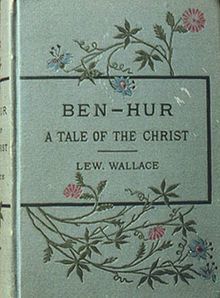 Image from Wikipedia.org
Image from Wikipedia.orgIf you’ve been around for more then a couple weeks here on The Starving Artist, you know that I love reading lists, especially thematic ones. I have lists for most of the major American holidays, at this point, but not Easter. That’s all about to change. Though, to be honest, this list isn’t that great. I’d love to have you all weigh in with your recommendations, because I couldn’t really find many suggestions with the usual Google searches. And boy is this list random. Easter is kind of that way, anyway, like Christmas: a hodgepodge of sacred and secular, of adult and children. There weren’t enough titles to sort them, but there’s a range from picture books to novels to nonfiction, Christian to heresy (at least I think it likely).
Ben-Hur, Lew WallaceThe Robe, Lloyd C. DouglasThe Last Temptation of Christ, Nikos Kazantzakis (perhaps heretical)The Message: New TestamentChocolat, Joanne HarrisThe Testament of Mary, Colm Toibin (perhaps heretical)Rechenka’s Eggs, Patricia PolaccoMiz Fannie Mae’s Fine New Easter Hat, Melissia MilichThe Berenstain Bears and the Easter Story, Jan and Mike BerenstainThe Parables of Jesus, Tomie dePaolaJunie B. Jones: Dumb Bunny, Barbara ParkGod Gave Us Easter, Lisa Tawn BergenThe Golden Egg Book, Margaret Wise BrownThe Country Bunny and the Little Gold Shoes, Du Bose HeywardKilling Jesus, Bill O’ReillyThe Cross and the Lynching Tree, James H. ConeThe Women of Easter, Liz Curtis HiggsBread and Wine (anthology)Easter is Coming¸ Christopher GreerEaster Stories (anthology)Journey to the Cross, Paul David TrippEastertide, Phyllis TickleThe Glory of the Cross, Tim ChesterHis Passion: Christ’s Journey to the Resurrection, David R. VeermanThe Crucified Is My Love, Johann Ernst Von HolstMarch 7, 2021
Book Review: I Think You’re Wrong (But I’m Listening)
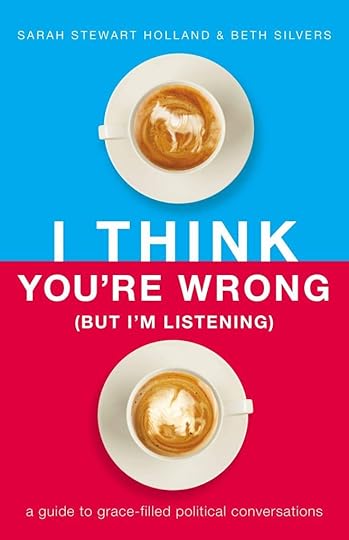 Image from Amazon.com
Image from Amazon.comWow. I really liked I Think You’re Wrong (But I’m Listening) by Sarah Stewart Holland and Beth Silvers. And so far in my pandemic reading, this has been my favorite of a number of okay to great books. Like, even more than wanting to run out and build a bunker or even relax into peace in difficult times, I really want to start a supper club small group called “Discussing Politics at the Dinner Table.” This book would be the center of that group and we would tackle one chapter per week, while we actually ate dinner together. See how clever that is? Challenging the traditional advice not to discuss politics over dinner. Wink wink.
The set-up of the book is to teach a different principal about grace-filled conversation in each chapter before exploring (briefly) an area in politics where this can be applied. For example, there is a chapter about embracing paradox that includes a short discussion on abortion (from both “sides,” applying all the principals in this book but concentrating on embracing the paradox of respecting women’s decisions and valuing life. (I oversimplified it in the way I just presented it, but I bet you get the idea.)) At the end of each of these principal-then-application chapters is a couple pages of discussion topics. This would make using this book for a group ideal, but would also work to apply in your own life, deeper than just reading it.
As the subtitle—A Guide to Grace-Filled Political Conversations—might tip you off to, the dual authors of this book are Christians. For some books, this means you really need to be a functioning member of that faith to benefit from the book. That is not the case here. Christianity is not so much crammed down anybody’s throats as yet another identity of the authors. It is occasionally referenced and also sometimes it is assumed that there are shared values and beliefs in order to “argue” a point. But I don’t think a non-Christian would have any issue getting some real value out of this book. As for Christians, well, I think that every single one of you should read this book. My husband will be reading it next (partly because I think he’ll enjoy it and appreciate it as someone who has been really ticked off about politics, and especially evangelical politics, for the last couple years) and then I’m making my teen daughter read it. This country would be a much better place if this were required reading (assuming that at least some people were open enough to embrace some of the ideas, because there are some difficult ideas here, some real life-changing, mind-blowing ideas, as simple as they often are).
 Image from Medium.com
Image from Medium.comThe title and cover should also clue you in that the authors are on opposite ends of the political spectrum in our bipartisan country. For a little background: they met in college but went their separate ways until awhile later. Both of them had ended up in politics one way or another, one as a Democrat and the other as a Republican, and they ended up starting the Pantsuit Politics podcast and then writing this book. What they are doing is not just arguing their points, it’s much more refreshing and revolutionary. They’re refusing to argue at all, but just discuss, beginning always with shared information that can be agreed upon and always ending up at a place of grace. It’s maybe not the best-written book or most engaging book you’ll read all year, but it’s well-written enough to make it an important one, considering its content.
You can’t go at this book with guns blazing, because that’s exactly the point: we’ve got to start treating everyone like humans, respecting everyone, and stop fighting like our lives depended on our opinions, blinding ourselves to reality and humanity with our preconceived notions and all-or-nothing political camps. The chapter titles might give you some idea what you are in for (as well as the few quotes I pulled, below): We Should Talk Politics, Take Off Your Jersey, Find Your Why, Put Politics In Its Place, Give Grace, Get Curious, Embrace the Paradox, Get Comfortable with Being Uncomfortable, Exit the Echo Chamber, and Keep it Nuanced. There really are some great ideas here, some great moments. There are many things I already believed or felt, and also many aha moments. I don’t necessarily agree with every single thing in the book, but with a book like this it almost doesn’t matter, because they’re teaching the reader how to deal with disagreements as they go along. I could certainly see people picking up this book, being offended, and walking away mad, but that would be a pity. This is a book you should read and learn from, walk away from a different person.
I intend to.
__________
QUOTES:
“Ultimately, politics is really about people” (p17).
“Somewhere along the way we stopped disagreeing with each other and started hating each other. We are enemies, and our side is engaged in an existential battle for the very soul of the country” (p24).
“We have viewed data, when we have it at all, through the lens of confirmation bias” (p38).
“And I have made a really deliberate choice in my life to prioritize grace over fairness” (p43).
“Followers substitute political figures’ judgement for their own” (p51).
“But these are concerns, not values…” (p55).
“…we found that our whys were identical” (p59).
“We think it would be helpful under any health insurance system for prices to be presented to patients in writing in advance of treatments in non-emergency situations” (p63).
“However, politics is not the only or even the most significant force at play in these problems, and government—or an absence of government—cannot be the only solution” (p73).
“Imagine the transformative impact of viewing our fellow citizens as though our big, messy country wouldn’t be complete without them” (p90).
“Grace simply means that all people are valuable. It does not mean that all opinions are valid” (p94).
“…policy positions are ideas. They are important and reflective of who we are, but they are not limbs” (p101).
“…politics is not a collision of good and evil; it’s a painstaking analysis of valid, competing priorities” (p121).
“Perhaps this is the paradox that we must embrace in all areas of political and moral debate. People can be moral and ethical beings who simultaneously reach decisions we ourselves might find immoral or unethical” (p129).
“…it is the discomfort that creates healing in the body” (p144).
“Discomfort is the path to growth; pain is a sign from that body that we need to disengage” (p147).
“We can look at our own behaviors, question ourselves, and still love ourselves. For people of faith, we can remember that this is how God sees us—flawed, sometimes reckless, always beloved” (p183).
Book Review: Northanger Abbey
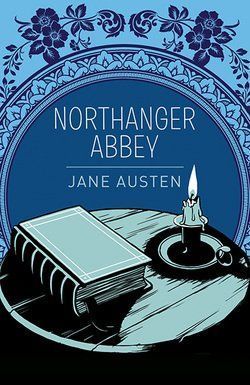 Image from booksamillion.com
Image from booksamillion.comIt seems obvious that I would have read all of Jane Austen’s books. In reality, I’m not entirely sure I’ve read any of her books except Emma, at least until this week. (I am a fan of many of the movies, including the Sense and Sensibility from the 90s: one of my all-time favorites.) Now I have also read—at the least—Northanger Abbey. How did I choose Northanger Abbey? I was looking for some Jane Austen to put on a book-a-week through-the-year reading list, and I wanted Austen but didn’t want to overwhelm people, so I chose her shortest book. Simple as that. Then I transferred any of those books that I hadn’t yet read over to my own reading plan and when February was at an end—there it was.
I also didn’t realize that, due to an early death, Austen only ever published six books, only four of them during her lifetime. Six! You’d think as a casual observer of world culture and literature, that there were a hundred, they come up so often and are talked about so frequently as a beloved body of work. She is something like the godmother of the modern novel, writing about the “normal” people and early on in the wave of “novels of manners,” which is how we think of many of the Victorian novels and nineteenth century writing. Austen, though born in the eighteenth century, was writing largely in and about the nineteenth.
I don’t think there are too many surprises in Austen’s novels, at least since most people have an idea what they are like and what they are about. The stories and some of the style remain all around our culture—from movie adaptations like Clueless to conventions, fan-fiction to spin-offs like The Jane Austen Book Club, etc. “Janeites” is a thing, not just in America, but around the world. And paradoxically, there are groups from opposite sides of feminism praising and commandeering her literature. From the vantage point of modern times, her stories come from a place of tradition and purity, and yet Austen often challenged or at least bucked convention with her characters and her strong female leads (as well as her keen wit which she used to expose and satirize the practices and culture of her day). So everyone claims them.
Northanger Abbey is a solid tale. I didn’t know anything about it except what I already knew about Austen when I picked it up. It’s not one of the stories that is adapted continuously. Catherine Morland is an unassuming heroine. Austen tells us so. She’s quite unlikely. She’s not especially talented, but is frank and naïve. She develops a love of the popular Gothic novels of the day—a love that is akin to today’s teens eating a steady diet of their favorite literary-, movie- or music-junk food (and whatever yours was), unapproved by many of the adults around her, thought by some to be a “girls” thing. The story is framed within this obsession, so that the whole story is a satire of the very type of novel Catherine would have read. Catherine is the unlikely heroine of her own novel and she is also the victim of said novel, as well as the victim of the combination between the garbage she’s read and her own over-active imagination. Skipping genres occasionally to give us tidbits of humor, mystery, and horror, in the end the story is classic Austen romance and also classic Austen fun.
Oh, but what is it about? Catherine is the first daughter in a very large parish family. She is asked by the childless Allens to accompany them on their summer trip to Bath for Mr. Allen’s health, where she traipses off to. While adorned literally by Mrs. Allen’s obsession with clothing and fashionableness, Catherine remains completely unadorned in other senses—she tries to act normal, but she is straight-forward and transparent to a fault. For me, it’s endearing and charming. She makes a new friend who consumes her for a time. Her brother finds romance. She finds romance. And somewhere along the line she is invited to Northanger Abbey—a real, live abbey just like in the novels she reads!—to stay with the sister of the one whom her heart pines for. It’s all very exciting, little clues about things in the background and people very obviously pulling things over on Catherine while she just tries to do the right thing, always. Thrown into the big game of Victorian marriage and the two-faced lives of high society, we wonder if Catherine will emerge in tact.
As long as you are capable of reading back a few hundred years (both in the language and the culture), there’s nothing to get in your way, here. The story is clear, engaging, well-peopled, and funny (if you can read a sidelong glance). I had a little issue when the copy I was reading—an anthology of all of Austen’s novels—had printed eight pages out of order. But I found my way, eventually, pretty much like an Austen heroine. You’ve got it all here, in this short book: love, deception, heroes, villains, and all the while the whole thing is being made fun of. Don’t look to shed tears: you’re never allowed to take Catherine too seriously. And I also was not as convinced about the main romance as I wanted to be, though I liked both of the characters and thought there were reasons to recommend them to each other. But still, what I loved about Emma was the clever weaving, the neat subtlety, the amusing Victorian restrictions, the fantastic characters, and the pure romp-ness of the thing. You get all this here in Northanger Abbey, just on a smaller scale and with the added lens of a Gothic spoof.
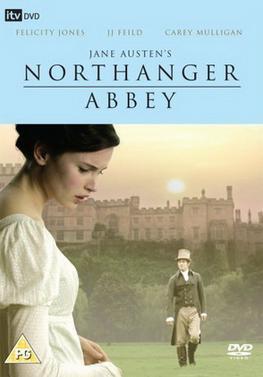 Image from Wikipedia
Image from WikipediaMOVIES
The only movie I really found that looked like it was worth watching was the 2007 PBS Masterpiece Theater version. After I also watched a segment of the 1980s version (oh my, so bad, and the hair so distracting!), I realized there were elements borrowed from the 80s version. What I mean is that the movies spread on the Gothic novel really thick, throwing us occasionally into Catherine’s imagination. They also make her imagination a little naughtier than what is portrayed in the book, which I think was a mistake. Yes, we are willing to go there nowadays, and people have always been naughty. And yet, I believe girls and women really did function differently back then, due to the repressions (and, dare I say, protection) of their society. I’m not sure they did imagine themselves hopping into the bathtub with some guy they just met, on average. It wouldn’t have occurred to many of them. So there. Other than that, the movie is a pared-down version (as they always are) of a more complicated plot and it works just fine. I liked the actors, and I don’t envy them the job of making Catherine’s and Henry’s romance pop. It barely does that on the page. It’s highly unlikely this will become your favorite movie, but once you’ve read Northanger Abbey, it’s the version you’ll want to watch, out of curiosity.
March 4, 2021
Book Review: Knowing God
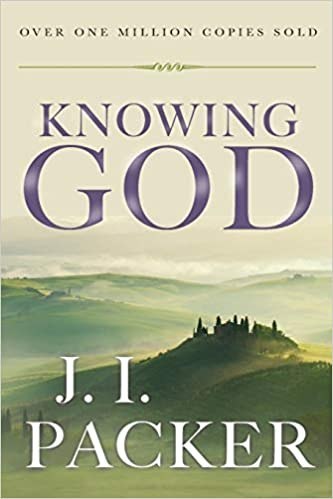 Image from Amazon.com
Image from Amazon.comFor the record, I would give this book 4.5 stars, but Goodreads makes me stick to one or the other, so…
Also for the record, it remains difficult to rate certain books, because they might be important or edifying, even though literarily they might not rank at the top end. I have found myself in this pickle quite a bit lately, especially with children’s books that are important for cultural (specifically racial issues) reasons but that don’t meet the top tier of my expectations as a great book. This book is less of a problem, and yet I have a hard time giving any religious book that might be important to someone’s spiritual development anything under a five. But then I do, cuz I’m stone-cold like that.
Knowing God by J. I. Packer is a classic of contemporary Christian literature. At least for protestants. (I’m not going to say evangelicals, because that word has gotten so, so charged (in a way I can’t identify with) and we’ll be chasing a rabbit trail on a campaign we can’t win, so…) It’s funny that I’m reading this shortly after Experiencing God, another classic published almost at the same time, in which Henry and Richard Blackaby go on a tirade at the start about how they didn’t call their book “Knowing God” because the point is not to know Him but to experience Him. A-hem. This is, clearly, semantics. The “knowing” that Packer is writing about is experiential in nature, and encompasses various facets of knowledge or aspects of knowing. For the record, I am much more partial to Knowing God than to Experiencing God, for a number of reasons. Note: I never got around to reviewing Experiencing God because I wasn’t keeping up with my small group’s pace. I will probably get around to it, someday. (Note: there are two Experiencing Gods. One is a chapter book and one is a workbook, and it’s quite confusing to decipher between them when purchasing.)
Back to Knowing God. It’s a little dense, a little heavy on the theology, for sure. Still, it’s basic theology, so I wouldn’t want to scare any Christian—new or quite old—away from reading it, though the way be slow and sometimes difficult. And while I’m sure different branches of American or Western Christians will find things to disagree with, Knowing God is pretty straight-forward and, well, orthodox, while also digging deep and looking at how that orthodoxy might apply to the believer’s life. I found it to be full of nuggets, certain chapters really jumping out to me and begging occasional re-reads on my path to implementing the ideas. (These include “God’s Wisdom and Ours” and “The Grace of God.”) There was one chapter I wasn’t fond of, and that was “The Only True God.” It asserts that we are not permitted to do paintings or any image of God or Jesus. I noticed that this is the same chapter that a friend of mine listed as the fly in the ointment of this book. Packer seems to be writing straight out of a personal beef, instead of the Bible, logic, tradition, and history, which I feel he uses well in the rest of the book.
I would definitely recommend it, if you are a Christian. Full stop. If you’re not much of a reader or into theology, it’s going to take you some time and patience, but it’s a classic that deserves a read, even as we get further away (sometimes further into) the cultural pitfalls that he occasionally addresses. (He is writing from England, 1973.) We all could use to better know God and to experience Him more.
__________
Some of the many QUOTES I underlined, starred, and otherwise marked:
“We must seek, in studying God, to be led to God” (p18).
“Yet the gaiety, goodness, and unfetterdness of spirit which are the marks of those who have known God are rare among us—rarer, perhaps, than they are in some other Christian circles…” (p21).
“What makes life worth while is having a big enough objective, something which catches our imagination and lays hold of our allegiance…” (p30).
“…knowing God is a relationship calculated to thrill a man’s heart” (p32).
“Whether being a servant is matter for shame or for pride depends on whose servant one is” (p32).
“…we must not lose sight of the fact that knowing God is an emotional relationship, as well as an intellectual and volitional one…” (p35).
“All my knowledge of Him depends on His sustained initiative in knowing me. I know Him, because He first knew me, and continues to know me” (p37).
“…the babyhood of the Son of God was a reality. The more you think about it, the more staggering it gets. Nothing in fiction is so fantastic…” (p46).
“Our minds can not get beyond this. What we see in the manger is, in Charles Wesley’s words, Our God contracted to a span; Incomprehensible made man” (p50).
“…how we should set [the incarnation] before ourselves and ever view it—not simply as a marvel of nature, but rather as a wonder of grace” (p51).
“It meant love to the uttermost for unlovely men, who ‘through his poverty, might become rich.’ The Christmas message is that there is hope for a ruined humanity…” (p55).
“…we can only appreciate all that our Lord meant when He spoke of ‘another Comforter’ as we look back over all that He Himself had done in the way of love, and care, and patient instruction, and provision for the disciple’s well-being, during His own three years of personal ministry to them” (p58).
“…nobody can prove the truth of Christianity save the Holy Spirit, by His own almighty work of renewing the blinded heart” (p63).
“Men sometimes say things that they do not really mean, simply because they do not know their own mind; also, because their views change…” (p70).
“The words of men are unstable things. But not the words of God” (p70).
“…how can we justify ourselves in resting content with an experience of communion with Him, and a level of Christian conduct, that falls so far below theirs?” (p72).
“The Christian’s instincts of trust and worship are stimulated very powerfully by knowledge of the greatness of God” (p73).
“Representations of God like these are meant to bring home to us the fact that the God with whom we have to do is not a mere cosmic principle, impersonal and indifferent, but a living Person, thinking, feeling, active, approving of good, disapproving of evil, and interested in His creatures all the time” (p74).
“He knows me as I really am, better indeed than I know myself” (p76).
“Living becomes an awesome business when you realize that you spent every moment of your life in the sight and company of the omniscient, omnipresent Creator” (p76).
“You tremble before the nations, because you are much weaker than they; but God is so much greater than the nations that they are as nothing to Him. ‘Behold your God!’” (p77).
“In Scripture wisdom is a moral as well as an intellectual quality…” (p80).
“God’s wisdom is not, and never was, pledged to keep a fallen world happy, or to make ungodliness comfortable” (p81).
“…he had held on to God while God weakened him, and wrought in him the spirit of submission and self-distrust” (p85).
“For what is this wisdom that He gives? As we have seen, it is not a sharing in all His knowledge, but a disposition to confess that He is wise, and to cleave to Him and live for Him in the light of His word through thick and thin” (p97).
“…our souls were made to ‘run’ on the practice of worship, law-keeping, truthfulness, honesty, discipline, self-control, and service to God and our fellows” (p103).
“It is perverse to quote John’s statement, as some do, as if it called in question the biblical witness to the severity of God’s justice” (p108).
“Grace is free, in the sense of being self-originated, and of proceeding from One who was free not to be gracious” (p119).
“…the New Testament doctrine is grace, and ethics is gratitude” (p124).
“The wrath of God… is a perfection of the Divine character…” (p142).
“…God’s mercy in grafting ‘wild’ Gentiles into His olive tree…” (p147).
“Nobody would imagine a jealous God. But we are not making up an idea of God by drawing on our imagination…” (p151).
“For God our Creator, Whom we could never have discovered by any exercise of imagination, has revealed Himself. He has talked” (p151).
“God’s jealousy is not a compound of frustration, envy, and spite as human jealousy so often is, but appears instead as a (literally) praiseworthy zeal to preserve something supremely precious” (p153).
“”…married persons ‘who felt no jealousy at the intrusion of a lover or an adulterer into their home would surely be lacking in moral perception; for the exclusiveness of marriage is the essence of marriage’” (p154).
“As He performs all the offices of a true and faithful husband, so He requires love and chastity from us…” (p155).
“…on the one hand, God does not feather-bed His children in this way, and anyone who thinks He does is in for a shock, and, on the other hand, that which is basic and essential to the real peace of God does not come into this concept at all” (p177).
“…the richest answer I know is that a Christian is one who has God for his Father” (p181).
“…not simply out of condemnation into acceptance, but one of bondage and destitution into the ‘safety, certainty, and enjoyment’ of the family of God” (p188).
“Sonship must be the controlling thought—the normative category, if you like—at every point” (p190).
“…authentic Christian living, springing from love and gratitude…” (p200).
“…the factor of God-given prompting and inclination, whereby one is drawn to commit oneself to one set of responsibilities rather than another, and finds one’s mind settled in peace as one contemplates them, becomes decisive” (p213).
“…is not a matter of inward promptings apart from the Word but of the pressure on our consciences of the portrayal of God’s character and will in the Word, which the Spirit enlightens us to understand and apply to ourselves” (p214).
“Trouble should always be treated as a call to consider one’s ways. But trouble is not necessarily a sign of being off track at all” (p217).
“Similarly, the Children’s guided life may appear as a waste” (p218).
“…take yourself in hand, talk to yourself, make yourself look up from your problems to the God of the gospel” (p236),
“For our faith, which from man’s point of view is the means of salvation, is completely God’s gift to us as is the pardon and peace of which faith lays hold. Psychologically, faith is our act, but the theological truth about it is that it is God’s work in us” (p241).
“…the passion for possessions has to be cast out of us in order to let the ‘all things’ in” (p246).
“…you are not strong enough to fall away while God is resolved to hold you” (p251).



